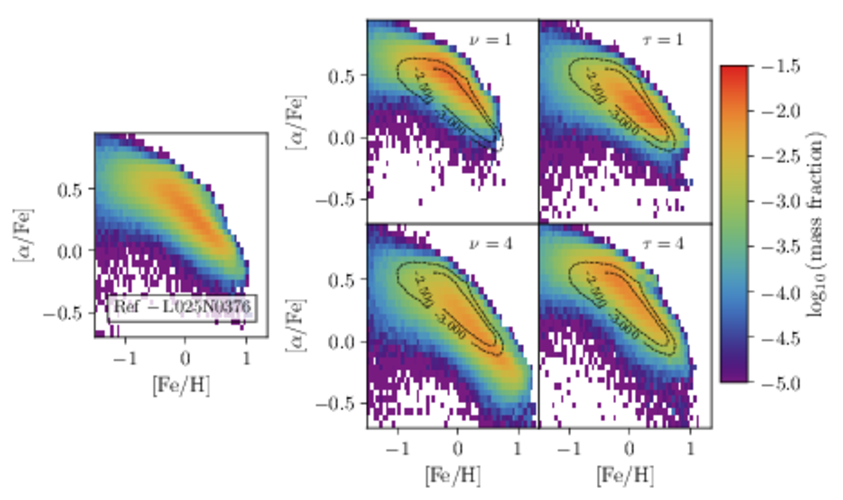
Figure 1
The mass weighted [α/Fe]-[Fe/H] distribution of stars in the disc regions of 133 Milky Way stellar mass galaxies

Spectroscopic surveys of the Galaxy reveal that its disc stars exhibit a spread, manifest at some locations as a bimodality, in [α/Fe] at fixed [Fe/H]. The origin of these diverse, and possibly distinct, stellar populations in the Galactic disc is not well understood. We examine the Fe and α-element evolution of 133 Milky Way-like galaxies from the EAGLE simulation, to investigate the origin and diversity of their [α/Fe]-[Fe/H] distributions. We find that bimodal [α/Fe] distributions arise in galaxies whose gas accretion histories exhibit episodes of significant infall at both early and late times, with the former fostering more intense star formation than the latter. The shorter characteristic consumption timescale of gas accreted in the earlier episode suppresses its enrichment with iron synthesised by Type Ia SNe, resulting in the formation of a high-[α/Fe] sequence. We find that bimodality in [α/Fe] similar to that seen in the Galaxy is rare, appearing in approximately 5 percent of galaxies in our sample. We posit that this is a consequence of an early gas accretion episode requiring the mass accretion history of a galaxy's dark matter halo to exhibit a phase of atypically-rapid growth at early epochs. The scarcity of EAGLE galaxies exhibiting distinct sequences in the [α/Fe]-[Fe/H] plane may therefore indicate that the Milky Way's elemental abundance patterns, and its accretion history, are not representative of the broader population of ~L* disc galaxies.
The gallery below contains the figures from the paper. Click panels for PDFs.

The mass weighted [α/Fe]-[Fe/H] distribution of stars in the disc regions of 133 Milky Way stellar mass galaxies

The mass weighted mean fraction of iron from the SN Type Ia channel in stars as a function of [α/Fe]-[Fe/H] in the disc regions of 133 Milky Way like galaxies

The mass weighted mean age of star particles as a function of [α/Fe]-[Fe/H] in the disc regions of the Milky Way like sample

The mass weighted mean gas consumption timescale at the formation time of star particles in the disc regions of the Milky Way-like galaxy sample as a function of [α/Fe]-[Fe/H]

Examples of galaxies in the Milky Way-like galaxy sample. Top panels show radiative transfer images from Trayford et al. (2015), middle panels show the [α/Fe]-[Fe/H] plane of each galaxy, and the lower panels show the star formation histories

The physics of [α/Fe]-[Fe/H] plane development in an example bimodal galaxy. Panels show how [α/Fe], [Fe/H], mean spherical radius, gas consumption timescale and fraction of Fe from SN Type Ia change with time for three populations in the [α/Fe]-[Fe/H] plane.

The cylindrical radius at formation vs. that at z=0 for star particles in the high and low [α/Fe] populations shown in Figure 6.

The paths in [α/Fe]-[Fe/H] space for high and low [α/Fe] populations in the six bimodal galaxy examples in the 100Mpc EAGLE simulation. The right two panels show the cylindrical radius vs. time for these two populations, and the mass assembly histories of the galaxies.

The mass assembly histories of the partner dark matter haloes of the Milky Way like galaxy sample. The median and interquartile range for bimodal galaxies is shown in red, demonstrating that they have an abnormal accretion history

The [α/Fe]-[Fe/H] planes under variations of the SN Type Ia subgrid model.
The movie below shows the evolution of an exemplar galaxy which demonstrates
bimodality in its z=0 [α/Fe]-[Fe/H] distribution. The top panels show the spatial evolution
of the gas and star particles which eventually make the galaxy, with the left and center showing
the gas which forms the stars at high and low [α/Fe] (which appear as dots as they form). The
right panel shows all the gas which ends up in the z=0 galaxy, but also shows colored dots representing
stars in the high and low [α/Fe] selections in the lower left hand panel.
The lower left hand panel shows the underlying distribution of stars in the [α/Fe]-[Fe/H] plane
in the disc at z=0, with the overlaid boxes demonstrating the particle selections making up high (coral) and
low (blue) [α/Fe] populations. As the movie evolves, the colored lines represent the mean [α/Fe]-[Fe/H]
of the gas that eventually forms these stars, as it becomes part of the galaxy, with the scatter points on top
showing when 75, 50 and 25% of the gas remains. The center and right panels show the median cylindrical radii,
and the SFR weighted mean gas consumption timescale of these two populations as they evolve.
This movie demonstrates the main pathway by which galaxies in EAGLE for [α/Fe] bimodality at fixed [Fe/H].
The high [α/Fe] stars are formed in a rapid collapse early in the galaxy's history, while the low [α/Fe]
star forming gas is still in the outer halo and subhaloes of the main galaxy. This early, rapid infall ignites an
extreme star formation event, where gas is consumed much faster than the timescale for SN Type Ia enrichment - and so
any formed stars are enhanced in [α/Fe] and concentrated in the galaxy center. The low [α/Fe] gas then begins
to accrete onto the galaxy at a much decreased rate, mainly due to the (now) high angular momentum of the galaxy. This slow
accretion forms the radially extended low [α/Fe], mainly spatially separated from the high [α/Fe] stellar population.
Later, radial mixing brings these populations into co-spatiality within the disc region, but the high [α/Fe] population
remains kinematically hot and centrally concentrated.